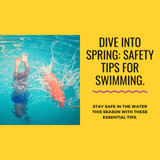Can You Swim With Contacts and Goggles?
Shop Prescription Swim Goggles
Swimming is one of America's favorite aerobic activities. Every year 36% of children and teens and 15% of American adults go swimming at least 6 times. And, swimming can increase cardiovascular health, boost lung capacity, and decrease your overall risk of death across all risk factors. This makes swimming one of the single healthiest and most beloved activities across all seasons.
But, what about the 45 million people in the US who wear contacts? Eye doctors are vigilant in warning contact owners not to swim in their contacts. But, what if you put a pair of goggles on? Shouldn't that protect your eyes?
Why You Should Never Swim in Contacts
You should never swim while you're wearing contacts. Water is host to billions of tiny, microscopic microorganisms that can cause serious damage to your eyes. From Legionella (which can cause pneumonia) and E. coli (which can cause diarrhea, nausea, and fever) to adenovirus (pink eye) and Acanthamoeba (which can cause blindness), pools are filled with bacteria.
Normally, small amoebas like Acanthamoeba are eradicated by your eyes natural defense systems. But, when you wear contacts, those small organisms can get trapped in the contact's pores, causing them to attack your eyes repetitively. And, contacts can also get pushed against your eyes by the pressure of the water causing irritation — opening your eyes up for further bacteria contamination.
This can lead to all sorts of issues. In the case of Acanthamoeba (which is found worldwide in water and soil), you can contract Acanthamoeba keratitis — which can cause permanent blindness.
Luckily, swim goggles exist, right?
Goggles Don't Help
The FDA strongly urges people not to swim with contact lenses in. In fact, contact lenses shouldn't come into contact with water of any type (e.g., pool, drinking, etc.) So, many people assume that an excellent pair of swim goggles will prevent water from touching their eyes, thus eliminating any potential risks. Unfortunately, no goggle can keep water out 100% of the time. Not only will you take your goggles on-and-off at some point, but microorganisms are extremely small. Acanthamoeba is 25 micrometers — or 0.000984 inches. Some of the tiny species of microorganisms get as small as 0.000007874 inches (or 200 nanometers).
Prescription Swim Goggles – Sports Goggles – Ski Goggles
Leader in Prescription Goggles and Glasses
Kids RX Swim Goggles – Adult RX Swim Goggles – Prescription Sports Goggles - RX Ski Goggles

 Canadian Dollar (CAD)
Canadian Dollar (CAD)
 Euro (EUR)
Euro (EUR)
 British Pound (GBP)
British Pound (GBP)







